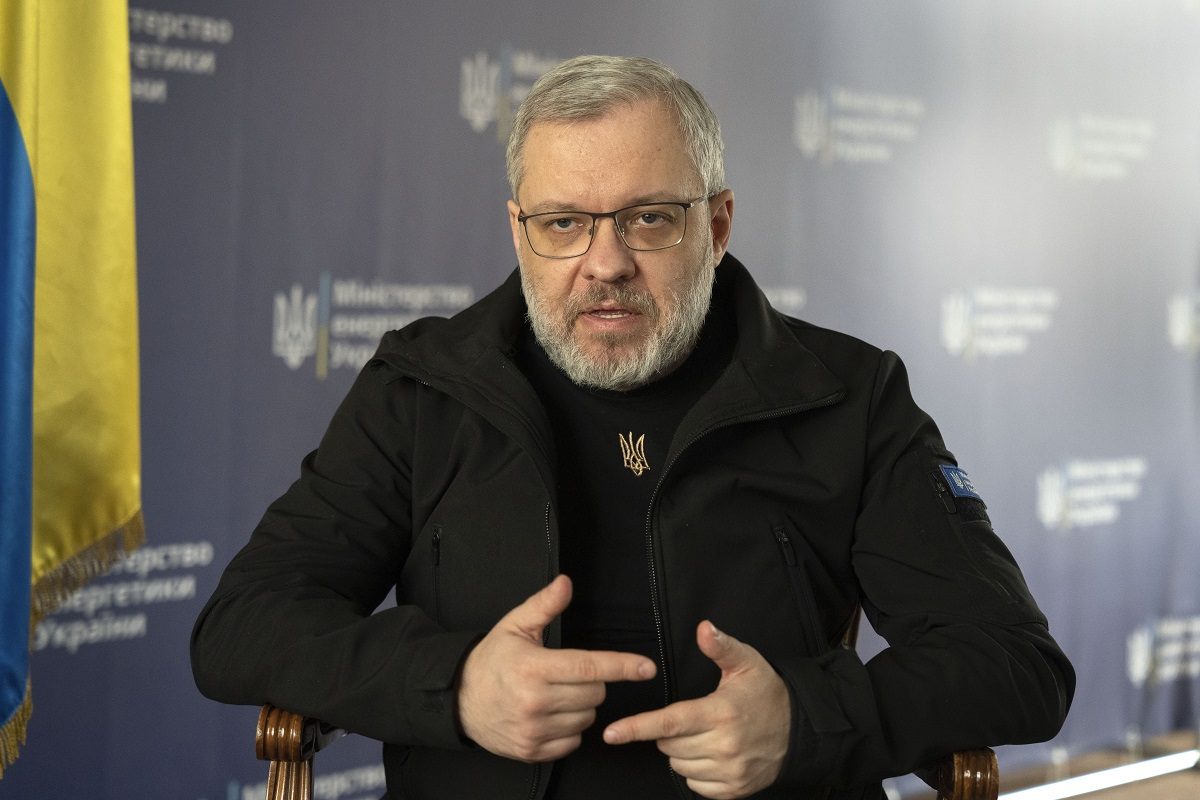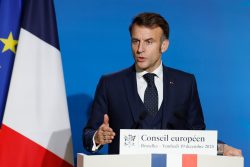
Herman Halushchenko, Ukraine’s energy minister, talks during an interview with The Associated Press in Kyiv, Ukraine, Tuesday, April 11, 2023.
12:48 JST, April 12, 2023
KYIV, Ukraine (AP) — Ukraine began resuming electricity exports to European countries on Tuesday, its energy minister said, a dramatic turnaround from six months ago when fierce Russian bombardment of power stations plunged much of the country into darkness in a bid to demoralize the population.
The announcement by Energy Minister Herman Halushchenko that Ukraine was not only meeting domestic consumption demands but also ready to restart exports to its neighbors was a clear message that Moscow’s attempt to weaken Ukraine by targeting its infrastructure did not work.
Ukraine’s domestic energy demand is “100%” supplied, he told The Associated Press in an interview, and it has reserves to export due to the “titanic work” of its engineers and international partners.
Russia ramped up infrastructure attacks in September, when waves of missiles and exploding drones destroyed about half of Ukraine’s energy system. Power cuts were common across the country as temperatures dropped below freezing and tens of millions struggled to keep warm.
Moscow said the strikes were aimed at weakening Ukraine’s ability to defend itself, while Western officials said the blackouts that caused civilians to suffer amounted to war crimes. Ukrainians said the timing was designed to destroy their morale as the war marked its first anniversary.
Ukraine had to stop exporting electricity in October to meet domestic needs.
Engineers worked around the clock, often risking their lives to come into work at power plants and keep the electricity flowing. Kyiv’s allies also provided help. In December, U.S. Secretary of State Antony Blinken announced $53 million in bilateral aid to help the country acquire electricity grid equipment, on top of $55 million for energy sector support.
Much more work remains to be done, Halushchenko said. Ukraine needs funding to repair damaged generation and transmission lines, and revenue from electricity exports would be one way to do that.
The first country to receive Ukraine’s energy exports will be Moldova, he said.
Besides the heroic work by engineers and Western aid, warmer temperatures are enabling the resumption of exports by making domestic demand lower. Nationwide consumption was already down at least 30% due to the war, Halushchenko said, with many industries having to operate with less power.
Renewables like solar and wind power also come into play as temperatures rise, taking some pressure off nuclear and coal-fired power plants.
But it’s unclear if Ukraine can keep up exports amid the constant threat of Russian bombardment.
“Unfortunately now a lot of things depend on the war,” Halushchenko said. “I would say we feel quite confident now until the next winter.”
Exports to Poland, Slovakia and Romania are also on schedule to resume, he said.
“Today we are starting with Moldova, and we are talking about Poland, we are talking about Slovakia and Romania,” Halushchenko added, noting that how much will depend on their needs.
“For Poland, we have only one line that allows us to export 200 megawatts, but I think this month we will finish another line which will increase this to an additional 400 MW, so these figures could change,” he said.
Export revenue will depend on fluctuating electricity prices in Europe. In 2022, while Ukraine was still able to export energy, Ukrainian companies averaged 40 million to 70 million euros a month depending on prices, Halushchenko said.
“Even if it’s 20 (million euros) it’s still good money. We need financial resources now to restore generation and transmission lines,” he said.
Ukraine has the ability to export more than the 400 megawatt capacity limit imposed by the European Network of Transmission System Operators for Electricity, or ENTSO-E. “We are in negotiations to increase this cap because today we can export even more, we have the necessary reserves in the system,” the minister said.
The current capacity limit is in line with what Ukraine was exporting in September 2022 before Ukraine diverted resources to meet domestic needs amid the Russian onslaught.
The 400-megawatt capacity is “only a start” as Ukraine pursues a long-term goal of becoming “truly integrated” into Europe’s network, which would increase its security of supply and help its neighbors exchange electricity, according to Georg Zachmann, energy policy expert at the Bruegel think tank in Brussels.
At a price of 100 euros per megawatt hour, the monthly income stream for Ukraine would at most reach 30 million euros.
As capacity increases, however, concerns will move from supply to commerce and politics due to Ukraine’s coal-fired plants paying almost nothing for carbon emissions, while EU competitors pay 100 euros per ton.
Halushchenko wants to increase the maximum technical capacity to 2 gigawatts. At the very least, he would like exports to meet the country’s import restriction of 850 megawatts, he said. ENTSO-E represents 39 electricity transmission system operators from 35 countries across Europe.
Ukraine began trading electricity with European countries in June, in a bid to move away from Russia’s sphere of influence. Power lines were synchronized in March 2022, shortly after the war began.
Engineers sped up the process to link Ukraine to the continental grid, allowing it to decouple its power system from Russia. Moldova was added later. Before that, Ukraine and Moldova were part of a power sharing system that included Russia and Belarus.
The resumption of exports is an obvious win for Ukraine, but it also benefits Europe, according to energy analyst Olena Pavlenko of the Kyiv-based think tank Dixie Group.
“European consumers need this, it increases competition in the (European) market, lowers prices and feels more energy secure,” she said.
“For Ukraine this is a solution to not just take money in grants and credit but to earn money. This is a good start for the future operation and partnership with the EU, as a business partner,” she added.
"News Services" POPULAR ARTICLE
-

American Playwright Jeremy O. Harris Arrested in Japan on Alleged Drug Smuggling
-

Japan’s Nikkei Stock Average as JGB Yields, Yen Rise on Rate-Hike Bets
-

Japan’s Nikkei Stock Average Licks Wounds after Selloff Sparked by BOJ Hike Bets (UPDATE 1)
-

Japan’s Nikkei Stock Average Buoyed by Stable Yen; SoftBank’s Slide Caps Gains (UPDATE 1)
-

Japanese Bond Yields Zoom, Stocks Slide as Rate Hike Looms
JN ACCESS RANKING
-

Keidanren Chairman Yoshinobu Tsutsui Visits Kashiwazaki-Kariwa Nuclear Power Plant; Inspects New Emergency Safety System
-

Tokyo Economic Security Forum to Hold Inaugural Meeting Amid Tense Global Environment
-

Imports of Rare Earths from China Facing Delays, May Be Caused by Deterioration of Japan-China Relations
-

University of Tokyo Professor Discusses Japanese Economic Security in Interview Ahead of Forum
-

Japan Pulls out of Vietnam Nuclear Project, Complicating Hanoi’s Power Plans
























